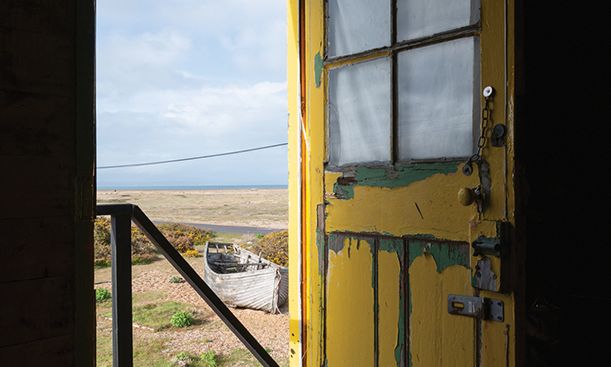Derek Jarman’s storied home, Prospect Cottage, in Dungeness, Kent, with the loft entrance
© Gilbert McCarragher
The garden that the writer, artist and film-maker Derek Jarman conjured up on a blasted plain of littoral shingle near Dungeness power station in Kent is, I would guess, fairly well known. Indeed, since Jarman’s death in 1994, his formula of sparse planting punctuated by totemic arrangements of post-industrial objets trouvés has overspread its faintly Dadaist roots and conquered the weekend lifestyle pages: there can be few gardeners within spitting distance of the seaside whose blessed plot doesn’t incorporate a few interesting pebbles, bits of rusty iron, railway sleepers and the like.
What is less well known, or it was to me, is the extent to which the garden was not just maintained but enhanced after the maestro’s death by “the widow Jarman”, Keith Collins, known to Jarman as Hinney Beast or HB, who worked variously as an IT guy, actor, fisherman and London Underground train driver, and was thus even more of a man o’parts than Jarman himself. Their relationship may have been technically chaste—“Keith had in the past joked that Derek was too old for him, and he had always been too old for Derek,” recalls the author and photographer Gilbert McCarragher in the book Prospect Cottage: Derek Jarman’s House—but it was none the less deeply nurturing and consoling for both parties.
McCarragher, a Jarman fan since his unhappy childhood in a ferociously homophobic Northern Ireland, and more recently a neighbour and then a friend of Collins, received the commission to photograph the garden and the enchanting if vaguely peri-apocalyptic shack at its centre in 2018. Collins had recently been diagnosed with a brain tumour and would soon die in hospital. McCarragher therefore had the run of the place at a liminal moment, when it was still what it had been—a weekend love nest, a studio for Jarman, a place for Collins to grieve, then begin to live again, all the while tending the garden and keeping the flame—but would doubtless in due course be scrubbed and sanitised, ossified into heritage.
McCarragher sees the house not so much as a document of a Great Man’s aesthetic life but as a place of intimacy and familiarity, where love, sorrow and laughter still charge the air. The result is less tidy than many books about artists’ houses, but it is considerably more affecting. Several of Jarman’s paintings still hang in the cottage; these get darker and cruder as his eyesight fades, one of many illnesses he suffered as a result of contracting Aids. Material relating to his career in film is mostly boxed up in the little attic, accessed by a rickety outside staircase; but there are a few stills on the walls, and a clapperboard and a plaster bust of Mausolus of Halicarnassus from The Tempest (1979). His trademark Bauhaus-style boilersuits hang on doors here and there.
There are many talismans made from the locally abundant “holey stones” strung together—McCarragher records his disappointment at never having been being given one of these by Collins—and a prodigious bronze dildo cast by the musician and occultist Genesis P-Orridge, copies of which were sent out to disfavoured record company execs (how it entered the Jarman collection is a mystery). There is some good brown furniture in the Kettle’s Yard vein. Jarman, or Collins, or both of them, used wire to bind things together in ad hoc union: a plastic He-Man figure and a statuette of an armless Grecian maiden; two chimney pots (“I found the act of the stronger pot lending its strength to the other comforting,” McCarragher says). Jarman carved little billets-doux to Collins into the surface of glass blocks, and attached John Donne’s poem “The Sun Rising” to the outside of the house, letter by letter.
“A place of intimacy and familiarity”: one of the found object arrangements in the interior of Prospect Cottage, from around 1988
© Gilbert McCarragher
One is used to seeing the house from outside: crisp, symmetrical and a little severe, its black weatherboards and yellow window frames providing a counterweight to the wispier forms of the garden and the bleak horizontality of the surrounding landscape. McCarragher tells us that Jarman began planting impulsively, staking a windblown dogwood to a piece of driftwood—more binding—but that it became a task of great significance to him, an act of remembrance for people with Aids and a defiant attempt to build and sustain something beautiful in a hostile place (though McCarragher cites local lore to the effect that the power station has created a microclimate that’s not unkind to plants). It seems that Collins, with a little professional help, introduced more colour to the garden after 1994.
Thanks to the Art Fund, Prospect Cottage was saved from the rapacious jaws of the housing market and is now open to the public, administered by Creative Folkestone, an arts quango energetically pursuing the goal of culture-led regeneration in a fairly embattled part of the world. Presumably some of the emotional vibrations that McCarragher captures so perfectly in his pictures, and discusses in the somewhat baggy text that accompanies them, will have been ironed out, much as Jarman himself deprecated the way the National Trust erased all trace of “the Sackville-Wests’ pursuit of naked guardsmen in the … herbaceous … borders” at Sissinghurst. But it must still be a piercingly lovely place.

